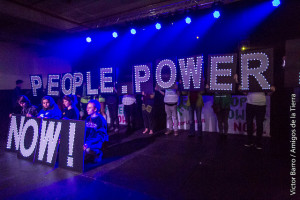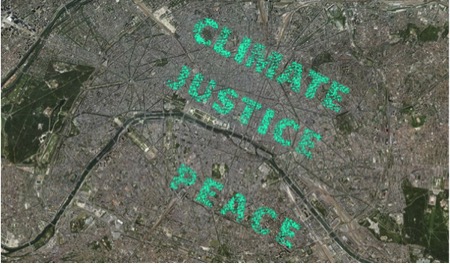
Our time in Paris
There is something odd about being in a city and feeling at the centre of the action, but knowing that the real action is taking place only a few kilometres away – and you haven’t been invited. Whilst we sang and chanted, danced with penguins and polar bears, and walked with angels, the Conference of the Parties (COP21) were completing the finishing touches to what has since been heralded as an ‘historic agreement’. Images of self-congratulatory and emotional Heads of State were splashed across the newspapers and on social media. Angela Merkel referred to the deal as an ‘historic turning point in climate policy’, whilst Catherine McKenna, Environment Minister of Canada noted that the ‘ambitious agreement’ was being welcomed not just by countries around the world ‘but by businesses, environmental NGOs and indigenous leaders’…

I arrived in Paris on Friday 11th December, along with a 45 strong Friends of the Earth Scotland delegation, to take part in an intense few days of activism aimed to coincide with the finalising of the COP 21. Only a few weeks earlier, the very idea of even being in Paris was unthinkable. The planned march, expected to attract up to 200,00 people, had been forbidden by the French Government in response to the terrorist attacks of 13th November and the appetite for marching wasn’t there for many. Others, however, felt that the attacks and subsequent clampdown on civil liberties made it even more important to be heard by those at the negotiations out at Le Bourget. In the Guardian (Nov 20th), Naomi Klein stated that by banning protests, Hollande would be silencing those facing the worst impacts of climate change ‘and its monstrous violence‘:
‘Its decision is disturbing on many levels. The one that preoccupies me most has to do with the way it reflects the fundamental inequity of the climate crisis itself – and that core question of whose security is ultimately valued in our lopsided world.’
Activists were told to make their protests at home ‘and march on behalf of those who can’t’ and thousands across the globe did just that. In Paris empty shoes were laid out on Place de la Republique: it was an impressive, gentle, yet immensely powerful and haunting image. The cancelled march was a knockback to the organising groups. Avaaz, 350.org and Friends of the Earth announced that whilst there would be no march, ‘other creative ways for people to make their voices heard in Paris would be sought’.
In two weeks, they did just that and, after much consideration, Friends of the Earth Scotland decided to join them, giving people the choice as to whether they wanted to take part or not. We ended up with a coach leaving for Paris on 10th December. A morning of preparation was organised in advance to allow us to meet and discuss forming affinity groups for the weekend of action.
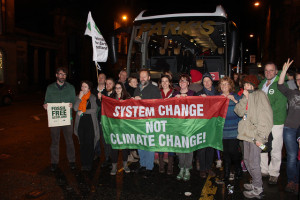
So what happened in Paris?
A hastily organised weekend of events took place and all credit to the organisers, particularly Les Amis de la Terre (Friends of the Earth France), who pulled together a programme of action, negotiating with the authorities until the last hour. They sought venues and refined carefully planned, peaceful actions. Many events had taken place before we arrived, including the Citizen Climate Summit from 3rd–5th December, a big anti-fracking gathering on 10th December and of course the Pinocchio awards on 3rd, highlighting fossil fuel industry bad practice. The three categories were: Lobbying: awarded to the company which has been lobbying the hardest to undermine climate policies. Greenwashing: awarded to the company which has led the most abusive and misleading communication campaign in regard to its actual activities and Local impacts, awarded to the company whose activities have the worst impacts on local communities. For the “winners”, see http://www.pinocchio-awards.org/
On Friday 11th December, a crowd of over 2000 met for ‘People Power Action’ in the Palais des Congrès. This brought together activists from across the world in a united show of solidarity. ‘Young Friends of the Earth Europe’ held their Climate Justice Assembly in parallel with the event; spaces were made available for informal networking or placard-making, and workshops were held to allow people to hear the first hand experiences of many communities affected by climate threats and to discuss how we could support their campaigns. These covered a range of issues from anti-fracking case studies, the campaign against the bank BNP Paribas and tax havens, oil wars in Nigeria, case studies of renewable energy in Palestine, to the role of young people of faith in the climate change movement.
I attended a session on ‘struggles against coal in Indonesia, Sri Lanka and South Korea’. I was particularly interested in this because of my long attachment to Indonesia. We heard from Hemantha Withange (an environmental scientist and founder of Sri Lanka’s Centre for Environmental Justice) and from Pius Ginting from WALHI (Friends of the Earth Indonesia). Hearing the issues of a coal importing country (Sri Lanka) and a coal producing country (Indonesia) served to illustrate the similar struggles faced by communities on the front line, the environmental, social and health costs and the outrageous violation of the rights of indigenous peoples by global corporations and their own governments. Pius spoke of fires raging across the forests and peat areas in Kalimantan and Sumatra: the resultant haze has led to around 500,000 acute respiratory infections. He also spoke of the mining holes which children have fallen into. WALHI is helping to evacuate vulnerable people, including children, and bring them to safety, whilst demanding the companies responsible be held to account and that those companies burning forests and peatlands are no longer funded. I regretted not taking Pius’s contact details, but found myself standing next to him on the street demonstration the day after, so rectified that. It was clearly meant to be.
Talks from senior figures in the environmental movement followed. The main programme was rounded off by Asad Rehman, Friends of the Earth International, who inspired those present by his passion, energy, and call for action. Before we left, we received a briefing on the mass participative and red line action for the following day. The subsequent music and dancing didn’t sit too kindly after the long coach trip, so some of us slipped back to the hostel for a well needed sleep and to ensure that we had energy for Saturday. (Whilst all this was going on, talks in Le Bourget continued and people were regularly checking social media for updates.) I had been following progress via Richard Dixon’s tweets and Mary Church’s regular updates. It was surreal to think of these very two parallel worlds unfolding in the same city. Richard managed to slip out to the venue to facilitate a workshop and give interviews and I know Mary was briefly there too, as her blog testifies:
‘On Friday evening, when I escaped from Le Bourget during a rare lull in the negotiations, the gathering of 2,000 Friends of the Earth members and supporters from around the world that I found myself at demonstrated very clearly to me where the real energy is to tackle this crisis head on. It’s in the communities fighting and winning the fights against fracking in the UK, oil in Adriatic, and new coal plants in India. It’s with the people fighting unsustainable agro-businesses in El Salvador and for clean water in Palestine. It is with the communities building their own renewable energy from Scotland to South Africa and Germany to the Gambia.’
Two events on Saturday 12th are worth noting. We congregated with others in the early morning at an assigned place with the Eiffel Tower clear to see, and learned about how we would be sending a global message for climate justice and peace across Paris through geolocation software. We broke up into our affinity groups, were given a specified location, and then spread out across Paris to spell out the letters ‘Climate, Justice, Peace’. Fortunately for our group (Cathy and Isla Ratcliff, Andy Wightman, Eryn, Rigley, Steve Smellie, Lauren Consoli and myself) the location was only a 2 minute walk away, so we were able to have café au lait and croissants before diving out at the assigned time to call in with smartphones. With everyone tuning in at 11am, the system crashed and some groups failed to connect, but the image picked up by the software was bold and glorious and the top part of the ‘E’ of Climate was made up of Scottish activists.
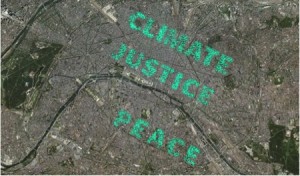
After ‘geo-locating,’ our group slowly made our way towards the Champs d’ Elysées to join a red line from the Arc de Triomphe, through the Avenue de la Grande Armée towards La Défense, where ‘Total’ has its HQ. Our Metro stop was closed due to the demonstration, so we got off at the next one and surfaced to be greeted by a sea of colour and a carnival atmosphere, the like of which I have not seen for a long time. My ‘buddy’ Lauren donned her latex penguin mask and attracted the attention (and cameras) of reporters far and wide. I found myself transfixed by the words of ‘Ciao Bella Ciao’, an Italian partisan/civil war song, which is sung across the world to represent freedom and resistance. It was perfect for the occasion. The brass band belted it out and we were handed tulips which had been laid on vast red sheets to represent the victims of climate change. I felt that I was part of an essential and important movement for change.…..and then people suddenly started walking and we commented on how because the police had blocked the side streets, this had resulted in an unplanned march (though I suspect that this had been carefully arranged in advance by the organisers and the police). Throngs and throngs of people filled the streets and chants in all languages filled the air as we headed towards the Eiffel Tower.
‘System change, not climate change.’
‘Below one point five, we may still be alive.’
‘Money’s not the answer. Stop buying stuff.’’
‘People. Power. Climate. Justice.’
My favourite placards were ‘It’s getting hot in here, so take off all your coals’ and ‘Take nothing but pictures, kill nothing but time. Leave nothing but footprints…’
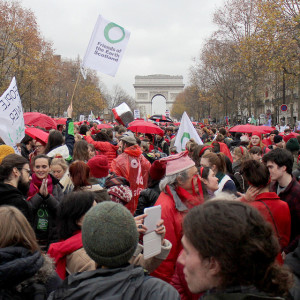
The evening culminated in a human chain circling the Eiffel Tower and the Champs de Mars. The COP21 Paris agreement text was then relayed to us from the bandstand. Apparently it had almost been agreed when the discussions had been re-opened over the words ‘shall’ and should’. Apparently, US Secretary of State, John Kerry told French Foreign Minister Laurent Fabius that this little word ‘shall’ would imply major legal and financial obligations and refused to agree. Four hours later, the gavel finally went down. Although adopted late on Saturday night, it had been preceded by days and weeks of hard bargaining. I look forward to hearing the inside story from Richard and Mary. To my near companions, the draft appeared to be more positive than we had expected, but we reserved judgment until we had seen the final text and analysis. Surely they had not agreed to a commitment of 1.5 degrees? Was this binding?
We then went for a bite to eat to reflect on the day (missing Naomi Klein’s address). Others had been involved in red line demonstrations earlier that day and we were keen to receive their updates. I went back to the hostel to wait for my friend’s daughter who had gone off to join a friend in Paris and was entertained in the reception by a group of local residents who were there for a reunion and was most impressed by Jim Orr’s excellent French.
As for the agreement….
We hadn’t expected much from the agreement and had low expectations from the start. We’d seen the pledges beforehand and we were well versed in the mantra that ‘Paris was just the start of the process’ and that ‘history will be made in what happens after’, so in a sense we knew that it was the beginning of a process. Friends of the Earth International, civil society groups, trade unions and community groups had agreed the ‘People’s Test on Climate‘ back in June 2015. The test was effectively a series of demands to use as a yardstick to measure the Paris Accord. I draw on this below, along with Friends of the Earth International’s verdict and highlights from the New Internationalist’s scorecard. Their conclusion is that the Paris Agreement fails the People’s Test on Climate. Overall the Paris Agreement fails the People’s Test on all counts. It not only has weak overall goals, but it lacks the specific concrete obligations to deliver on emissions reductions, finance for transformation and justice for affected peoples. It does not rule out false solutions. It is a bad one for climate justice. (FOE International) http://www.foei.org/news/friends-earth-international-assessment-paris-agreement
Click here for a separate blog offering a thorough analysis of the text and reaction from key players.
Heading home but beginning a journey
On the long journey home, we eagerly checked the papers to see how the Agreement had been reported. We groaned when we saw the headline ‘environmentalists welcome historic accord to tackle climate change’ and noted in disbelief that the Observer’s piece entitled ‘World leaders hail Paris climate deal as ‘major leap for mankind’ was followed on the next page with ‘Vital Heathrow expansion must not be held up by craven politics,’ puzzling at how people failed to make the connections. It reminded me of the placard bobbing in front of me on the march ‘Facts do not cease to exist because they are ignored’. Huxley was spot on.
We cheered when we heard that Marine le Pen’s National Front had been thwarted in her attempts to get beyond the second round in the French regional elections and we booed as we passed Torness Nuclear Power Station. I spent a few hours chatting with one of the smartest people I have ever met, conversing about the pros and cons of the Brompton bike, the Norwegian language and listened attentively to his insight on the Windscale fire of 1957, the Penney report and the name change to Sellafield.
One of our fellow passengers, Ric Lander quickly wrote a post and circulated it. One paragraph in particular is worth highlighting.
We have drawn our red lines. The UN deal threatens to cross them. If we were celebrating anything on Saturday, it was the start of this fight. Every one of the 15,000 in Paris were representing thousands more of you, the movement, fighting on around the world – like the Queen’s University Belfast students occupying for fossil fuel divestment this weekend. A whole climate justice movement, built on the solidarity of new global alliances between indigenous groups, workers and peace activists and armed with a fearless radicalism, is renewed and dispersed from Paris today to the four corners of the earth.
We all felt a mixture of exhilaration from our meetings and the warm sense of solidarity one gets from being with people who are passionate about the same thing, yet we felt a little robbed. We were conscious that Richard Dixon, Director of FoES, and Mary Church, Head of Campaigns, had been following the daily discussions, highlighting changes to the text – the words written in square brackets that had held promises of real ambition, only to get deleted as the process drew to a close.
We had a quick de-brief on the ferry home and had talked about what had gone well and what we would do next. We were left with the feeling that it had been important to be in Paris, but that we needed to do so much more. For me, the failure of mainstream politics was writ large. We know that, despite the evidence, politicians will continue to act in the interests of powerful corporate and vested interests and respond to short electoral cycles. We know that they will continue to do so until we change the system and act together as a strong, global climate movement supporting those across the world who are fighting climate injustice. Never before has the slogan ‘System change not climate change‘ felt so right.
Máire McCormack is Chair of Friends of the Earth Scotland
Follow her on Twitter
Read the second part of this blog here: did paris climate deliver
You can see many of the photos included in this blog at the Friends of the Earth International Flickr and Friends of the Earth Scotland Flickr

